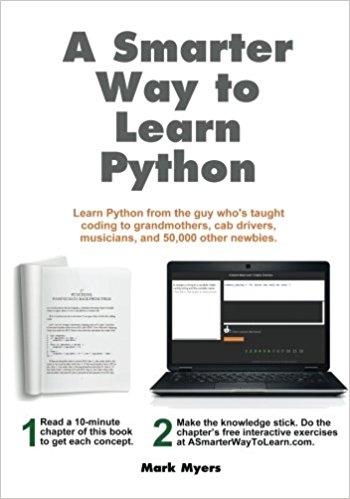Are you a Python beginner? Do you want to learn Python but you haven’t written the first line of code yet? If you need to jumpstart your career with Python, check A Smarter Way to Learn Python.
If you are looking to start your journey in Python, “A Smarter Way to Learn Python: Learn it faster. Remember it longer” by Mark Myers would be one of the books that will ease your way in.
| The book |
| Exercises |
| Pros and cons |
| Conclusion |
The book
A Smarter Way to Learn Python would cover your basics (loops, data structures, variable types, how to write/read files, etc) in a way I never saw before.
When you think in programming books, an 800+ pages book with 40+ pages per chapter packed with endless boring theory comes to mind.
But not this one. This book’s structure is pretty different to what we are used to.
It has just 236 pages, but there is a lot inside. With 236 pages and 77 chapters (an average of 2.5 pages per chapter), this book reads like a breeze.
In every chapter, you learn a new Python concept. It might be what a class is and how to create one, how to loop a dictionary by its keys or how to append a text in a .txt file. Most of the text is code. with a brief theoric introduction. Very straight and to the point.
Then, the fun begins.
Exercises
After every chapter, you have a link to the author’s website. In here, you’ll be tested by 12 exercises in the subject you just have read about.
These exercises are tiresome and repetitive. And you will like them. A big range of exercises would be hard for the beginners; this way you feel like you’re drilling an exercise at the gym. Over and over. This way, not only you understand it and learn it, but you build your muscle memory. Your fingers will fly over the keyboard typing without thinking.
Type the first 3-char key at the start of a method. Then create a method without parameters, after that, create a method with one parameter. Now type the proper word inside the empty space in a method. Over and over, in 12 exercises per chapter.
As I said, the structure (a lot of chapters, 2-3 pages per chapter, only useful information) makes quite lightweight to read. The author tells you to spend 5 minutes reading the chapter, then 10-15 minutes doing the exercises, then go for a walk, rest, etc so you can simmer the information.
As proof of its lightweight, I read the book in one weekend (Friday afternoon till Sunday night), doing every single exercise, and sometimes a bit of playing around the code.
Granted, I’m not a beginner, but a non-programmer can read the book without a hurry in a few weeks in his spare time and learn a lot.
Pros and cons
Pros
- Repetitive exercises (Good for understanding and muscle memory)
- Chapters build up in what you have learned previously. You feel like you’re learning as everything is connected.
- Lightweight to read
- Cheap
- Fun
Cons
- Teaches just the basics of the language
- Even it has exercises, you don’t build a portfolio you can show to others or push it to github
- You don’t build a complete program.
- Doesn’t touch basic packages (timezone, random, requests, pillow, etc)
- It doesn’t teach anything related to databases
- It is not a
n “All you need to start coding Python and get a job” book.
Conclusion

Even if the book has a lot of cons, you have to judge the book as what it is: An introduction to new Python programmers.
It won’t scare any new user with a technical, plus than 800 pages book, full of theory. Starting from the first page, you will be coding and feeling like you are learning. And learning you will be.
If you are a beginner and you want to learn what this “Python fever” is about, or you want to jumpstart your early career in Python without spending 1 month learning only theory before your first “Hello World”, this is your book.
Also, after doing all the exercises you get this cool certificate:
Click for more book reviews



